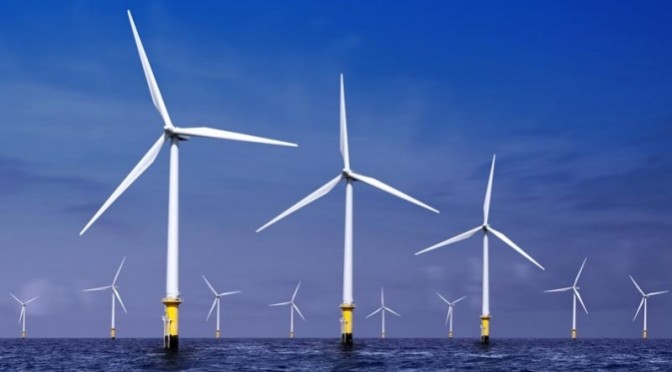A Seattle company is being given the green light to develop plans to build the West Coast’s first offshore wind energy farm—five floating turbines off Oregon’s Coos Bay, federal and state officials said Wednesday.
The 30-megawatt pilot project was announced at a press conference by Gov. John Kitzhaber, U.S. Secretary of the Interior Sally Jewell and Bureau of Ocean Energy Management Director Tommy Beaudreau.
Though offshore wind farms are an expensive source of energy, proponents say they could bring clean, efficient electricity, create new jobs and stimulate the economy.
“It’s not going to be economic out of the gate,” Beaudreau said. But “it’s important for Oregon to be on the edge of what could be a huge industry in the future.”
The pilot project will be developed by Seattle-based Principle Power using floating wind turbine technology that has not been deployed in U.S. waters but is in use or under development in Europe and Asia.
The Oregon facility would be 15 miles from shore, in about 1,400 feet of water. The turbines would be connected by electrical cables and have a power cable to transmit electricity to the mainland.
The turbine towers would rise 600 feet to the highest point of the blade tip.
Several offshore projects are in the works on the Atlantic coast, but they don’t use floating platform technology. Instead, they are anchored to the seabed.
Experts say the West Coast has not yet seen offshore wind projects because the technology needs are different.
The ocean gets deeper more quickly on the West Coast, so turbine towers cannot be planted directly into the seabed, said Belinda Batten, director of the Northwest National Marine Renewable Energy Center at Oregon State University. Instead, companies need to use devices supported on floating platforms.
Another challenge in bringing the technology to Oregon, where cheap hydropower from dams is plentiful, is the price tag. But that should not be a deterrent, Batten said.
“We’re not as anxious to commercialize it, but it’s still worth getting the projects into the water and testing them,” she said. “As we learn how to deploy and maintain them, the price will come down.”
In December 2012, Principle Power, Inc. received $4 million in Department of Energy funding for the project—one of seven to receive funding and the only one on the West Coast. The DOE plans to select up to three of the proposals to go forward with an additional $46.6 million dollars.
The Seattle company submitted a request to the Bureau of Ocean Energy Management for a commercial wind energy lease in May 2013. Since other developers were not interested in constructing wind facilities in the same area, the company may now submit a plan under the noncompetitive process. The federal agency will then complete an environmental analysis, which includes opportunity for public comment, before making a final decision.
Fishermen on the southern Oregon coast have agreed to support the project, but concerns remain, said Steve Bodnar, executive director of the Coos Bay Trawlers’ Association.
“Albatross and other birds could be chopped up in the turbines. And we still don’t know if the sound or the electricity will interfere with sensitive species like salmon, Dungeness crab and whales,” Bodnar said. “We’re hoping to learn from this… whether it justifies wrecking prime fishing ground, displacing people and jobs.”
Offshore wind power has been the new frontier in renewable energy. Proponents say better wind speeds are available at sea than on land, creating more electricity than other projects. The turbines are less noisy and less visible than on land.
The industry has grown chiefly in Europe, where several dozen offshore wind farms operate. China is also developing projects. In November, Japan revved up a wind farm off the coast of Fukushima.
In the U.S., several offshore wind farms are in the works off the Atlantic coast. In Nantucket Sound off Cape Cod, a company has been cleared to build 130 turbines that would supply 75 percent of the power for Cape Cod, Martha’s Vineyard and Nantucket. In Rhode Island, a five-turbine farm off Block Island that would generate electricity for about 10,000 homes is being planned.
New Jersey is considering a pilot 25-megawatt, six-turbine offshore wind farm to be built 2.8 miles off Atlantic City. And the University of Maine and partners plan to build two turbines generating 12 megawatts of power south of Monhegan Island. The university has launched a prototype wind turbine off the coast near Castine.
Last year, the federal government auctioned leases for ocean sections where projects can be developed—including off the coasts of Massachusetts, Rhode Island and Virginia. Auctions off the coasts of Maryland, New Jersey and Massachusetts are expected in 2014.


